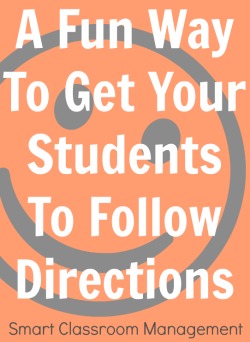
It doesn’t improve by making a fuss about it or showing your frustration over it.
And it doesn’t improve by pointing out to students how often or how poorly they’ve messed it up.
The only surefire way of improving your students’ ability to follow directions is to employ strategies that compel them to tune you in, determine what you want them to do, and take action as soon as you give your ‘go’ signal.
One such strategy is to slip a meaningless step into your directions. It’s a bit unorthodox, to be sure, but it’s remarkably effective.
It also happens to be a lot of fun.
Here’s how it works:
Give a multi-step direction.
Breaking a single direction down into several steps will make it more effective. So, for example, if you want your students to pick up science materials from a front table, you would walk them through specific points along the way, modeling in detail how you want them to get out of their seats, walk to the table, gather what they need, and return.
The points, or steps, act as hooks along a memory map, ensuring a smooth, efficient process and a clear understanding of what is expected.
Add a meaningless step.
A meaningless step, especially if it’s silly or out of the ordinary, causes students to listen more intently to your directions and better visualize what you want them to do. It’s a technique that perks them up, sparks their interest, and binds the steps together.
Your extra step can be a dance move, a line from a movie (“To infinity and beyond!”), jumping jacks, or a simple two-beat clap of the hands. What you decide is limited only by your imagination, your level of comfort, and the age and maturity of your class.
Increase complexity.
One of the keys to improving following directions is to increase the challenge. If you give the same, boring, non-specific directions all the time, then your students will glaze over. More steps—and more detailed, interesting steps—equals better performance.
You can also add more than one meaningless step. For example, you might have your students start the science-materials procedure with five push-ups and then end the procedure with them looking at their lab partner and saying, “Let’s do this!”
Grooving The Habit Of Good Listening
Following directions well is equal parts listening, clear purpose, and motivation. Adding a meaningless step heightens and intensifies each of these for your students. It doesn’t take a lot of time to implement, and it will save you oceans of time in the long run. It also adds another layer of fun and interest to your classroom.
It isn’t a strategy you’ll want to use all the time, however. The novelty will wear off quickly if you put it into practice more than a couple times per week. Sparingly used, though, it’s one of many strategies you’ll find in our archive that will dramatically improve this most important area of classroom management.
It gets your students following directions the right away—with intention, accuracy, and efficiency. It grooves the habit of actively listening and reacting to the sound of your voice. It moves them yet another step closer to your goal of creating a sharp, attentive group of students who can’t wait to get to your classroom every day.
If you haven’t done so already, please join us. It’s free! Click here and begin receiving classroom management articles like this one in your email box every week.

I cannot wait to try this idea. I have noticed that when I give the signal, and begin “In a moment…” it takes longer for some of my kinders to stop, look and listen. I think this will help put us back on track. Michael, I LOVE your work. This is my second year using your strategies, and I love it! Very, very effective.
Thanks Maria! I think you’ll like this strategy.
Michael
I receive your articles in my email and am so happy I do. I loved reading this article. On my blog I have a Classroom Management Link-Up going on an would love for you to link up this post if you are interested. I think a lot of other teacher bloggers would enjoy this article too.
If you are interested the link is: http://mindfulrambles.blogspot.com/2014/01/all-about-classroom-management-new-linky.html?m=1
Thanks for the great post!
Rae
My little preschool students will love this, thank you!
You’re welcome, Christine!
Hi Michael
I tried this this week, I gave a few instructions and somewhere in the middle I added that they should walk a full circle around their desks.
it was fun, but a few kids were acting “goofy” bumping into other kids/desks and being silly. the class got loud and a bit chaotic
I still like the idea and would like to try it again. do you have any pointers/insights that would encourage better cooperation and make it more successful?
Itzy
Hi Itzy,
It was new. They should get better with time. Also, you’ll get better with time choosing the right tasks for your students.
Michael
Hello!
Thank you for sharing informative and innovative ideas in this site…I really appreciate it and I’m trying to do in my class.
I am please to hear from you more.
God Bless!
Anthony
You’re welcome, Anthony!
Michael
I’ve read every single blog post several times over the years! I’ve employed these methods and they really do work! This is a fun one, even for my high school juniors and seniors. The first day of school I had them turn in an “all about me” sheet they had filled out and pick up a bingo card for a fun game. Before returning to their seat, they were to show respect to their classmates by either bowing or curtseying, their choice. It was hilarious! A great way to a) follow directions b) learn that respect is important in my room and c) get the year off to a great start!